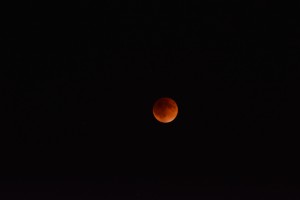Lunar eclipse inspires Hesston College
Cheri Baer – News Editor
Free front row seats to a cosmic light show? That’s an offer that sounded pretty good to nearly one hundred Hesston College students who filled the soccer bleachers last Sunday night. Some were motivated by offers of extra credit. Others showed up to witness a phenomenon that won’t occur again until 2033: An eclipse of a super moon. Sophomore Rachel Shenk was one of these fascinated students in attendance.

“It was interesting to see the progression of light over the course of the evening.” she said. “And I loved getting to spend time with friends as we just marveled at God’s awesome creation, rather than just spending our whole evening inside doing homework.”
Students asked for scientific explanations as they looked for places to sit.
“So why is this happening to the moon?” freshman Yoel Bobadilla asked. “Never mind, I’ll look it up.”
Eventually, the crowd gathered at the edge of the soccer field for campus worship, where Jim Yoder spoke about the lunar eclipse significance from a Christian perspective. Rince Longo, a sophomore from the Republic of Congo, came away from the soccer field with some new thoughts about the phenomenon.
“Through this experience I learned that God still uses the firmament as a sign as said in the Old Testament,” he said.
But that isn’t the only interesting thing students learned about the moon.
“I learned about why the moon actually looks reddish, and I also was introduced to the Biblical connections that the ‘blood moon’ has,” Shenk said “I had previously heard about various Israel [prophecies], but I did not know the science behind the blood moon.”
So why did the moon turn red that Sunday evening? The phenomenon has to do with the electromagnetic spectrum. When the earth completely blocks the sunlight to the moon, light still travels through our atmosphere to the moon. We have about 50 miles of atmosphere extending above earth’s surface that the sunlight passes through to reflect off of the moon. Because that atmosphere filters out the green to violet portion of the visible light spectrum, and the only light left to reflect off of the moon is the longer wavelength of the visible spectrum: the color red. This light reflects off of the moon and we see a reddish tint to the moon while it is in eclipse.



